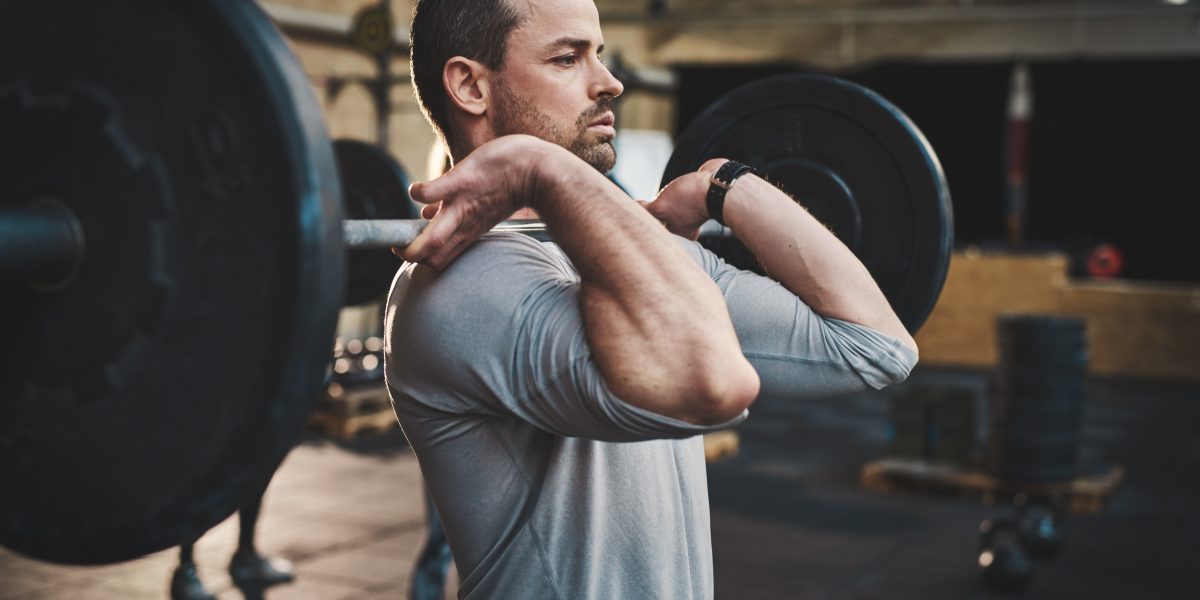Shoulder pain when lifting sucks! You are just trying to stay healthy, but your body seems to have other ideas. Suddenly all your dreams of weight loss and healthy living seem to hang precariously on one stupid, petulant shoulder that can’t just exercise like its supposed to. It has to complain. Loudly. And often during your favorite activities: lifting and sleeping!
Shoulder pain is a common problem for everyone. In fact, shoulder pain is the most common thing that brings people to my orthopedic surgery practice. It can cause problems whether you are a couch potato or a highly-trained athlete. Sadly, shoulder pain when lifting is one of the most common reasons people stop exercising. That’s good news for the insulin manufacturers; pretty bad news for the rest of us.
Regrettably, many of the exercises that we do in the gym can cause impingement and pain if they aren’t done right. The average weekend warrior’s combination of poor daily posture combined with the new fitness trend of WODs with high rep overhead exercises can really grind away at the shoulder and lead to major problems if you aren’t careful!
When you combine garbage posture with a high volume of shoulder exercises, you get some really bad outcomes!
How Do You Prevent Shoulder Pain While Weightlifting?
There are two simple steps to preventing impingement. Step One: Learn proper shoulder positioning and movement patterns. Step Two: Apply them to everyday life as well as the gym!
I know, I know! It’s way more complex than that. But don’t worry, we’ll go way beyond those basics in this article. (And we are going to be coming out with an educational video series on proper shoulder mechanics and motion soon. It will be helpful for both coaches and athletes, so if you are interested, drop your email in the big green box on this page.)
Other Names For Shoulder Impingement
Shoulder impingement syndrome has many synonyms. Some other terms for shoulder impingement include subacromial bursitis, rotator cuff tendinitis, rotator cuff tendinosis, shoulder bursitis, and subacromial impingement. These are all essentially the problems that result from shoulder impingement, and they often occur together.
The Cause of Impingement and The Keys To Prevention
To prevent impingement syndrome, you have to know the cause. In this article we’ll tell you about some important shoulder anatomy, talk about the patterns of movement that lead to impingement, and how to keep it from happening to your athletes. We’ll cover:
1. Shoulder Impingement Anatomy
2. Other Problems that Shoulder Impingement Can Cause
3. Why We get Shoulder Impingement Syndrome While Lifting
4. Preventing Shoulder Impingement While Lifting
5. Exercises Most Likely to Cause Impingement
6. Lifting With Shoulder Impingement
7. What To Do if Shoulder Pain Won’t Go Away
The Anatomy of Shoulder Impingement
Shoulder impingement syndrome occurs when the tendons of the rotator cuff get squished between two different bones: The humerus and the acromion.
The humerus is your arm bone, from shoulder to elbow. And the acromion is part of your shoulder blade.
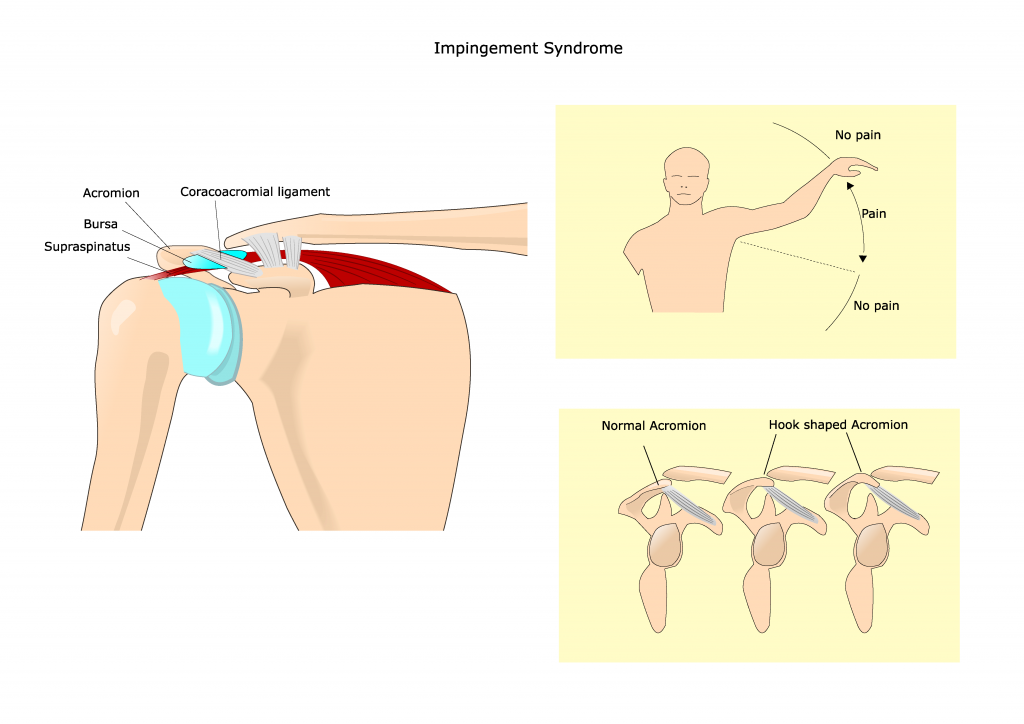 What is the Rotator Cuff?
What is the Rotator Cuff?
The rotator cuff tendons attach to the top of the humerus. The cuff is a set of four muscles that start on the shoulder blade and end on the humerus, and they are like a fine-tuning mechanism for the shoulder.
The cuff helps to spin the ball and socket joint. Without the rotator cuff, the shoulder would slip and slide, often dislocating in the process.
It’s important to remember that these are tiny muscles and they can’t lift much. One of the biggest mistakes people make when trying to rehab the shoulder is going way too heavy. When you grab a twenty-pound dumbbell, you are aren’t rehabbing anything! You are probably just exacerbating the problem.
The two cuff muscles that are the most active in overhead motion are the supraspinatus and the infraspinatus. They are both toward the top of the shoulder which makes them the most vulnerable to impingement and the most likely to tear. You can get even more in-depth discussion about the rotator cuff and shoulder anatomy in this article.
What is the Shoulder Bursa?
The bursa is a thin space between the cuff and the acromion. When you have impingement, it can lead to inflammation in the bursa and adhesions between the cuff and the acromion. (If you want to learn more about adhesions between the different layers of your body and the problems that can cause, check out this awesome interview “Fixing Fascia” with a Scott Dolly.)
One of the concepts that confuses a lot of patients is the idea of a “bursectomy.” Surgery for a painful bursa doesn’t really involve removing the bursa itself. The bursa is supposed to be an empty space. But you can’t remove an empty space. Removing a bursa would be like trying to dig a hole out of your yard. Instead, what we do is to remove the adhesions that have grown across the bursa and filled it up. So essentially we are taking the garbage out of the bursa and opening up a nice clean space again.
Other Problems That Shoulder Impingement Can Cause
You know how some days you get up and nothing fits right? Your pants are too tight, static cling makes your shirt stick to your arms, and even your underwear seems to bunch in all the wrong places.
Bursitis is sort of like that, just on the inside of your body! Everything is stuck together, nothing moves well, and it can cause a lot of annoyance or even pain. Sometimes bursitis progresses beyond a simple irritation and can become a major problem. In fact, I’ve seen people with bursitis that had just as much pain as someone with a broken shoulder!
Shoulder impingement can lead to some truly major issue if left untreated. Early impingement causes shoulder bursitis. Over time, impingement does microscopic damage to the rotator cuff. Impingement will eventually cause breaking of the tendon fibers and it will kill the tendon cells.
Eventually, that microscopic damage will build up to cause a real cuff tear. And then you are looking at a major surgery! And please, please, PLEASE do not try to rehab through a full rotator cuff tear!
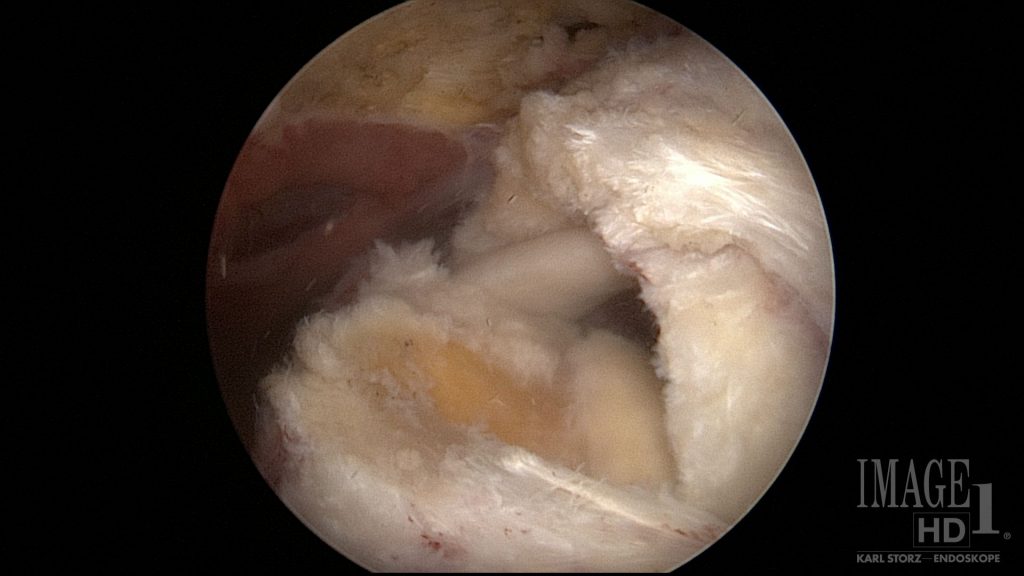
What Happens When You don’t Fix a Rotator Cuff Tear?
Partial cuff tears can heal, but complete full thickness tears won’t. Some other popular fitness and rehab blogs have written articles about how their methods allowed one athlete or another rehab through their cuff tear and still compete. What they don’t tell you is that those same athletes had surgery to fix the tear after the competition season.
I know what happens when you ignore your cuff tear and keep lifting. You end up like the 50-year-old powerlifter I saw just today in the office. The torn parts of the cuff simply atrophied away. There was nothing left to even try and repair.
He can only lift a tenth of the weight he used to. He can’t bench press or do push-ups. He has pain every time he tries to lift his arm overhead. His shoulder often hurts at night and keeps him up.
He felt better for a few years after he tore his cuff. He did rehab and got the rest of the shoulder stronger. But now it hurts again. And he’s got no good options.
There isn’t enough rotator cuff left to fix. He is too young for the reverse shoulder replacement he’ll eventually need. And partial shoulder replacement might help relieve some of his pain, but its far from complete relief. Maybe he could get a complex surgery to transfer a muscle from his back to the shoulder. But that surgery would never let him get back to heavy lifting either.
Why We Get Shoulder Impingement While Lifting
Impingement of the rotator cuff typically occurs when you lift your arms overhead. The most likely angles for impingement occur between 60 and 100 degrees, especially when lifting directly to the side (abduction) or when the arms are rotated out (external rotation.) Check out these pictures to see what I mean.
These are the positions where the rotator cuff tendon can get crushed directly between the humerus and acromion. Above this level, the cuff has moved beyond the acromion and isn’t in much danger. Below these levels are where the cuff hasn’t moved into the crushing position yet.
And this is where poor posture comes in to play. If your shoulders are slumped and your posture sucks, you’ll roll the shoulder blades forward. This moves the acromion directly over top of the rotator cuff, just waiting to crush it with any overhead motion. If you then add any further motion, like pushing or pulling, you start sawing away at the cuff that’s jammed up against the acromion. Ouch!
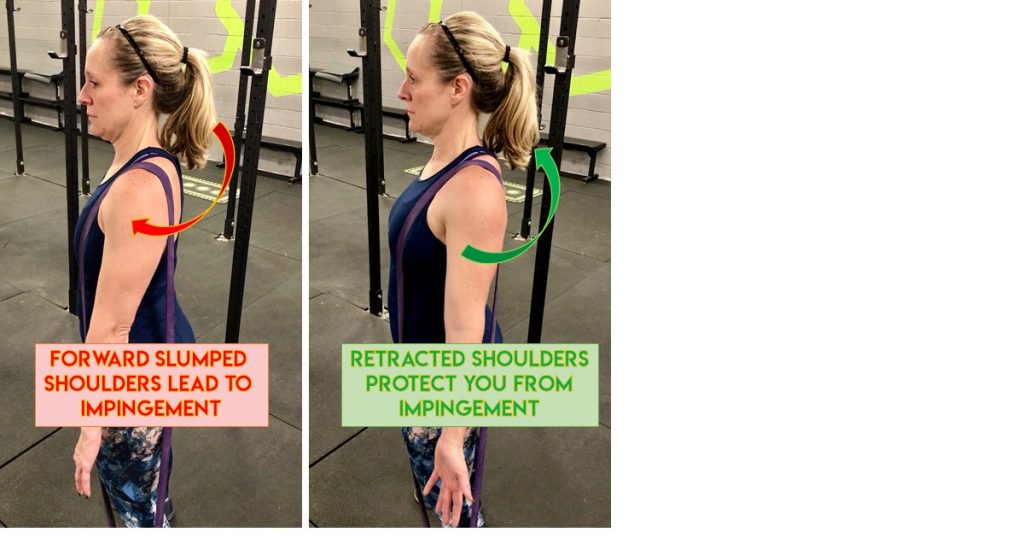
A Metaphor for Shoulder Impingement
When I was in high school, my best friend had a sporty little Japanese import car. It was old and had a lot of miles on it. But it was way cooler than the “chargold” family minivan with faux wood-paneling stickers down the side that I got to drive. The only problem was my height. I was 6’5″ at the time, and my head bounced off the roof of the sporty little import with even the slightest bump in the road.
Well, in nice weather we could open the sunroof and let my head peek out through the roof of the car! No more impingement! You see, when we lift while hunched forward the acromion slides over the cuff, just like the closed roof over my head. Any little motion causes impingement. But with proper position of the shoulder blade, you can open that sunroof and let your shoulders raise up all the way overhead without getting crushed against the acromion.
Bone Spurs Can Cause Impingement
The shape of the acromion can make some people more likely to get impingement syndrome. If the acromion is hooked, the spur in front can rub on the cuff during motions like kipping or bench press. If the acromion is too wide it can also be a problem. With a wide acromion or one with a bone spur, there is less room to move before impingement occurs.
This is how bone spurs cause impingement, bursitis, and cuff tears. But in many cases, learning how to properly position your shoulder during exercise can help prevent impingement from spurs in everyday life too.
Sometimes the bone spurs can be too big to avoid. No matter how you position your shoulders, those people may still have problems. Sometimes the only way to solve that problem is with surgery. But we’ll talk more about that at the end of the article.

Preventing Shoulder Impingement While Lifting
In the cross-training box or gym, coaches and trainers are key players in preventing shoulder impingement. Most certification courses teach coaches simple verbal cues that can help prevent shoulder problems.
So even if you only hold a Level 1 Certificate, you have probably already learned ways to save your athlete’s shoulders. You just may not realize it! When you are out there shouting “big chest” and “show me your pits” you are doing it to save your clients’ shoulders!
Preventing shoulder pain is vital for the health of your athletes and for the health of your gym. If you let someone jack up their shoulder, do you think there is a high chance of them sticking with you as a coach or with your gym?
Or worse yet, what if you pushed the athlete into finishing a workout with terrible form and actually encouraged their injury! That’s not why you got into coaching! You are here to help people (of course the free gym membership is nice too.) Impingement syndrome will cost your gym customers if you don’t focus on prevention!
While poor positioning can cause rotator cuff impingement, proper form can help prevent it.
“Keep Your Chest Open” is a common phrase to hear from coaches and trainers. But why do we give athletes this verbal cue? So that their pecs look good on Instagram?
Well, partly… but that’s only a side benefit! The main reason is that it puts the athlete’s shoulders in excellent position to prevent impingement. It forces the athlete to squeeze the shoulder blades down and back.
Scapular Control
When your shoulder blades are pinched together and depressed toward the pelvis, two things happen.
The first is that you have provided a solid base of support and control for your shoulder. The shoulder blade is now firmly engaged upon the thoracic wall and ribs. That makes it set to translate the core-to-extremity momentum of the lift.
This is what we refer to as Scapular Control, and it’s soooooo important in preventing shoulder injuries. We need to think about scapular control as much as we think about core control, maybe more!
The second thing that happens when you open your shoulders is that you swing the acromion wide open. This gives the rotator cuff a nice clear zone to pass through while going overhead. An open chest means an open shoulder, and that means less pinching and less impingement.
Flexibility and Mobility Are Vital To Preventing Impingement
Shoulder Flexibility can really help prevent shoulder impingement. If your range of motion is limited you will have to force it into compressed positions in order to do many exercises. The shoulder tendons and ligaments all spiral around the joint. So as you rotate your arm the fibers around it all squeeze tightly; it’s as though you’re wringing out a towel.
That tightening leads to shoulder impingement. In fact, limitations to the motion of your shoulder can account for up to 10 % of the impingement pressure! If you want some great ways to stretch out your shoulder, you can check out our previous post on exercises to prevent shoulder pain.
Tight chest muscles can limit your shoulder motion. Most people don’t realize it, but tight pecs can really keep your shoulders closed and prevent full overhead motion. The pec muscles pull your shoulder forward, where impingement is likely. So be aggressive about rolling and stretching the pecs if you are trying to prevent shoulder pain.
Exercises That Are Most Likely To Cause Impingement
Sumo High Pull Deadlift
Overhead Press
Push Press
Push Jerk
Pullups
Ab Wheel
American Kettlebell Swing
Push ups
Bench Press
Sumo High Pull Deadlift:
Sumo High Pull Deadlift is a powerful training tool with a very narrow window of correct motion. To properly perform this lift, the shoulders have to remain retracted and open the entire time. But most people perform the lift incorrectly, leading to frustratingly high rates of injury.
I personally feel that it should be considered an advanced lift, not a foundational move. I wouldn’t program it regularly in workouts. I’d consider it something skilled athletes can add to their training.
Overhead Press, Push Press, and Push Jerk:
Overhead Press, Push Press, and Push Jerk can lead to impingement as well. But errors in form while pressing overhead are much more forgiving. But if the shoulders don’t have full range of motion, it can lead to excess strain and impingement.
Weightlifters tend to arch their back to makeup for any deficits in shoulder motion. If you see that an athlete arches their back too much, check their shoulder mobility!.
Pullups:
The classic way to injure your shoulder during pullups is actually on the way down. This applies to standard pullups and the kipping and butterfly variants. If you let yourself simply drop from the bar, you’ll hammer the cuff against your acromion! You could even dislocate your shoulder if you are “double jointed” or hyperlax.
A slow controlled descent will make sure that you are avoiding injury. It’s why I recommend that controlled, slow kipping be a primary prerequisite to teach some one the kipping pull up.
Ab Wheel and American Kettlebell Swing:
Both of these exercises put your shoulder through a full overhead motion with the arm internally rotated. The arms are directly in front of the body and the thumbs are pointed in toward each other. You are generally much safer if you are in a “thumbs up” position. So that simple change in rotation when your arms are forward and going overhead can lead to impingement.
I don’t recommend the ab wheel at all, I’ve seen too many shoulder injuries from it. There’s a reason that people call it the “Death Wheel.” (Of course that name usually makes HIIT athletes perversely determined to try this exercise!) Yet another reason why I will always have a job! You know, sometimes if something doesn’t kill you, it merely makes you wish for death!
Full overhead American Kettlebell Swings should also be considered a more advanced move. Athletes looking to be competitive at a local or regional level will be expected to perform them. But you average beginner should probably stick to Russian swings. Athletes without adequate shoulder motion risk injuring their cuff and their spine.
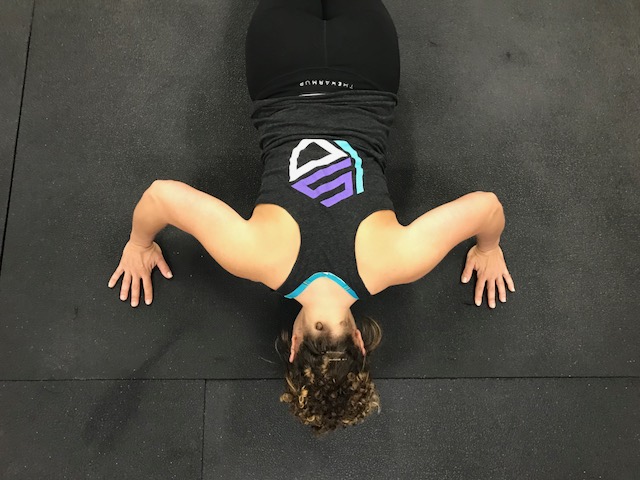
Push Ups and Bench Press:
Both of these can cause shoulder impingement, or make it worse if it’s already a problem. But impingement usually only becomes a problem if you keep your arms too wide. When your grip is super wide, it puts your shoulder into the position of impingement. Then you start to press or push up, and you start sawing that rotator cuff tendon against the bone!
So keep your hand position more narrow in order to prevent shoulder pain when doing push-ups and bench press. And be sure to pinch the shoulder blades together to provide a solid base to push from. Remember your scapular control!
Lifting With Shoulder Impingement
It is totally possible to lift with mild shoulder impingement. Of course, severe cases may require that you stop upper body weightlifting. But if you catch the problem early, and adjust your technique, you can often prevent impingement from developing into something worse.
A little louder for the people in the back row: DON’T KEEP LIFTING THE SAME WAY IF YOU ARE HAVING SHOULDER PAIN!!!
People always say “I don’t need therapy. I’m already very active.” Well, duh! How do you think you got this problem in the first place? Usually by being very active with poor posture, bad form, and terrible mechanics. If you think you’ll get better by repeating the same mistakes, think again!
It is vitally important to work with your coach, trainer, or therapist to correct your mechanics. Slow down and work on your scapular control. This usually means swallowing your pride and focusing on the small accessory muscles instead of the big sexy muscles you want everyone to admire!
Ways to Modify Your Workout for Shoulder Pain
Keep your hands and arms closer to your body during push ups and bench press.
Avoid hanging from a bar until you can do so without pain. “Just a little pain” isn’t good enough.
Try using dumbbells instead of a barbell to do your overhead presses. This will let your shoulders find the path that is most comfortable, and prevent most impingement.
Take the time to work on rotator cuff strengthening. These are tiny muscles and they need light weights.
Spend extra time stretching and mobilizing your back, chest, and shoulders.
For some more details about specific exercises and stretches, take a look at this article we published on that subject. Complete with photos and descriptions!
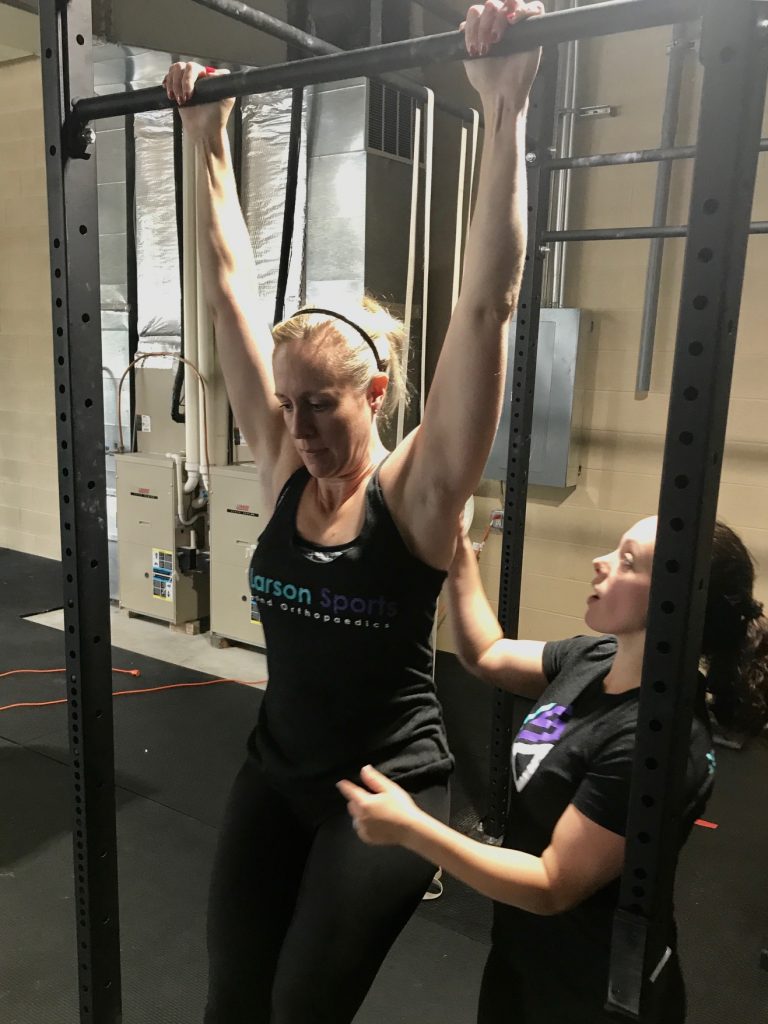
What to Do If Shoulder Pain Won’t Go Away
So an important caveat to all of this involves how the pain started. If you had a sudden injury with sharp pain and can hardly move your arm, go see your doctor right away!
But if you have had persistent discomfort for several weeks despite changing your exercise routine and giving your shoulder some rest and ice, it’s probably best to see a specialist. An orthopedic surgeon would be great, but other professionals like primary care doctors and physical therapists can also be very helpful.
If the pain has been going on that long, it may indicate a real tear or other damage.
Medical Treatment of Shoulder Impingement
You may need an injection or medication to help settle the shoulder. I usually find, and this is supported by studies, that shoulder pain does better if treated with both therapy and an injection at the same time.
You may not be able to prevent impingement if you have a giant bone spur. Sometimes our anatomy is our own worst enemy. All the mobility in the world won’t stop cuff damage if you have the “Hook from Hell” on your acromion!
In this case, you may need to have the bone spur surgically removed to stop shoulder impingement. Luckily, that is a simple outpatient surgery. It is usually done arthroscopically, and you can usually return to lifting within a month or so.
But it is important to try an injection and physical therapy before having the surgery. I see more shoulder patients than most orthopedic surgeons in the country. And I find that with good therapy we can avoid surgery in better than 90% of my patients with impingement! Yay!
If you do need an evaluation, you can schedule an appointment through my office. Here’s the link to my professional page.
Bringing It All Home
So remember, preventing shoulder impingement is important not only for athletes but for gyms and coaches also. Educated coaches can help provide proper lifting tips and monitor form to prevent injury during high-risk exercises. Don’t ignore pain and injuries: You’ll only make it worse.
Learn to focus on proper recovery after a minor injury. You’ll get back to your normal form faster if you take the time to heal instead of pushing through the pain. Take care of yourself so you can stay healthy in the long term.
Works Cited
Coats-Thomas, M S, et al. “In Vivo Evaluation of Subacromial and Internal Impingement Risk in Asymptomatic Individuals.” American Journal of Physical Medicine & Rehabilitation.
Heuberer, P R, et al. “Critical Shoulder Angle Combined with Age Predict Five Shoulder Pathologies: a Retrospective Analysis of 1000 Cases.” BMC Musculoskeletal Disorders.
Mackenzie, T A, et al. “Relationship between Extrinsic Factors and the Acromio-Humeral Distance.” Manual Therapy.

